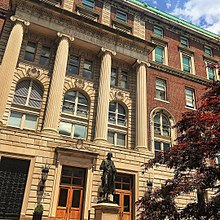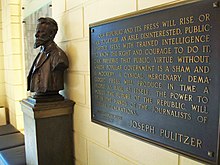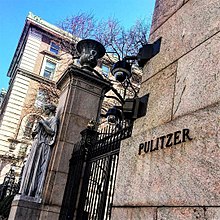Columbia University Graduate School of Journalism

 Clash Royale CLAN TAG#URR8PPP
Clash Royale CLAN TAG#URR8PPP
 | |
| Type | Private |
|---|---|
| Established | 1912 |
| Founder | Joseph Pulitzer |
| Dean | Steve Coll |
| Students | 361[1] |
| Location | Manhattan, New York City New York , United States |
| Campus | Urban |
| Website | journalism.columbia.edu |
The Columbia University Graduate School of Journalism is the journalism school of Columbia University. It is located in Pulitzer Hall on Columbia's Morningside Heights campus in New York City.
Founded in 1912 by Joseph Pulitzer, Columbia Journalism School is the only journalism school in the Ivy League and one of the oldest in the world. It offers four degree programs: 1) master of science; 2) master of arts; 3) a variety of dual degrees, including a master of science in journalism and computer science; and 4) a doctor of philosophy in communications.
The school houses the Pulitzer Prizes, arguably journalism's most prestigious award. It also directly administers several other prizes, including the Alfred I. duPont–Columbia University Award, honoring excellence in broadcast and digital journalism in the public service. It co-sponsors the National Magazine Awards, also known as the Ellie Awards, and publishes the Columbia Journalism Review, a widely respected voice on press criticism since 1961.
In addition to offering professional development programs, fellowships and workshops, the school is home to the Tow Center for Digital Journalism, which explores technological changes in journalism, and the Brown Institute for Media Innovation, which supports innovation in storytelling in the digital age.
Admission to the school is highly selective and has traditionally drawn a very international student body. A faculty of experienced professionals preeminent in their respective fields, including politics, arts and culture, religion, science, education, business and economics, investigative reporting, and national and international affairs, instruct students. A Board of Visitors meets periodically to advise the dean's office and support the school's initiatives.[2]
Contents
1 History
1.1 First journalism graduate school
2 Academic programs
3 Journalism awards
4 Accreditation
5 Notable alumni
6 Faculty
7 References
8 Further reading
9 External links
History

Pulitzer Hall
In 1892, Pulitzer, a Hungarian-born newspaper magnate, offered Columbia University President Seth Low funding to establish the world's first school of journalism. He sought to elevate a profession viewed more often as a common trade learned through an apprenticeship. His idea was for a center of enlightened journalism in pursuit of knowledge as well as skills in the service of democracy. "It will impart knowledge - not for its own sake, but to be used for the public service," Pulitzer wrote in a now landmark, lead essay of the May 1904 issue of the North American Review.[3] The university was resistant to the idea. But Low's successor, Nicholas Murray Butler, was more receptive to the plan.[4]
Pulitzer was set on creating his vision at Columbia and offered it a $2 million gift, one-quarter of which was to be used to establish prizes in journalism and the arts. It took years of negotiations and Pulitzer's death in October 1911 to finalize plans. On September 30, 1912, classes began with 79 undergraduate and postgraduate students, including a dozen women. Veteran journalist Talcott Williams was installed as the school's director. When not attending classes and lectures, students scoured the city for news. Their more advanced classmates were assigned to cover a visit by President William Howard Taft, a sensational police murder trial and a women's suffrage march. A student from China went undercover to report on a downtown cocaine den. A journalism building was constructed the following year at Broadway and 116th Street on the western end of the campus.
First journalism graduate school
In 1935, Dean Carl Ackerman, a 1913 alumnus, led the school's transition to become the first graduate school of journalism in the United States. As the school's reach and reputation spread, due in part to distinguished early scholars who included Douglas Southall Freeman, Walter B. Pitkin and Henry F. Pringle, it began offering coursework in television news and documentary in addition to its focus on newspapers and radio. The Maria Moors Cabot Prizes, the oldest international awards in journalism, were founded in 1938, honoring reporting in Latin America and the Caribbean. The Alfred I. duPont-Columbia Awards for excellence in broadcast journalism was created in 1942. In 1958, the Columbia Journalism Award, the school's highest honor, was established to recognize a person of overarching accomplishment and distinguished service to journalism. Three years later, the school began publishing the Columbia Journalism Review.[5]

A Joseph Pulitzer bust and plaque in the Columbia Journalism School lobby
In 1966, the school began awarding the National Magazine Awards in association with the American Society of Magazine Editors. Former CBS News president, Fred W. Friendly, was appointed the same year to the tenured faculty and enhanced the broadcast journalism program. By the 1970s, the Reporting and Writing 1 (RW1) course had become the cornerstone of the school's basic curriculum. The Knight‐Bagehot Fellowship was created in 1975 to enrich economics and business journalism. In 1985, the Delacorte Center for Magazine Journalism was founded.
A doctoral program was established in 2001. In 2005, Nicholas Lemann, two years into his tenure as dean, created a second more specialized master's program leading to a master of arts degree. As a result of industry changes forced by digital media, the school in 2013 erased distinctions between types of media, such as newspaper, broadcast, magazine and new media, as specializations in its master of science curriculum. The Toni Stabile Center for Investigative Journalism, dedicated to training select students interested in pursuing careers in investigative journalism, opened in 2006. A year later, the Spencer Fellowship was created to focus on long-form reporting. The Dart Center for Journalism and Trauma relocated to Columbia in 2009 to focus on media coverage of trauma, conflict and tragedy.[6] In 2010, the Tow Center for Digital Journalism was created. The Brown Institute for Media Innovation was launched in 2012.[7][8]
Academic programs
The school's ten-month master of science program offers aspiring and experienced journalists the opportunity to study the skills, art and the ethics of journalism by reporting and writing stories that range from short news pieces to complex narrative features. Some students interested in investigative reporting are selected to study at the Stabile Center for Investigative Journalism, a specialization of the master of science program. Documentary and data journalism specialization programs are offered as well. The master of science program is also offered on a part-time basis.[9]
A year-long master of science program in data journalism teaches the skills for finding, collecting and analyzing data for storytelling, presentation and investigative reporting.[10]
The school offers several dual-degree programs in collaboration with other schools at Columbia: journalism and computer science, journalism and international public affairs, journalism and law, journalism and business, and journalism and religion. The school also offers international dual-degree programs with Sciences Po in Paris, France and the University of Witwatersrand in Johannesburg, South Africa.[11]
The smaller, nine-month master of arts program is for experienced journalists interested in focusing on a particular subject area: politics, science, business and economics or arts and culture. Master of arts students work closely with journalism professors and take courses in other academic departments and schools at the university. The program is full-time.[12]
The doctoral program draws upon the resources of Columbia in a multidisciplinary approach to the study of communications. Students craft individual courses of study to acquire deep knowledge in an area of concentration through research and coursework in disciplines ranging from history, sociology or religion to business or international affairs.[13]

The Broadway and 116th Street Main gate outside Pulitzer Hall
Journalism awards
The school administers many professional awards, a tradition Joseph Pulitzer began when he founded the school and endowed the Pulitzer Prizes at Columbia, honoring excellence in journalism and the arts since 1917.
The 19-member Pulitzer Prize board is composed mainly of leading journalists and news executives. Five academics also serve, including the president of Columbia and the dean of the Columbia Journalism School. The dean and the administrator of the prizes are non-voting members. Distinguished professionals are appointed to serve on juries that judge thousands of entries. They are asked to offer three nominations in each of the prize categories to the board, which makes the final decisions.[14][not in citation given][15]
The school also administers the Alfred I. duPont–Columbia University Award, the National Magazine Awards, the Maria Moors Cabot Prizes, John Chancellor Award for Excellence in Journalism, the Lukas Prizes, the Oakes Prizes, the Mike Berger Award, the Paul Tobenkin Memorial Award and the Dart Awards for Excellence in Coverage of Trauma.[16]
Accreditation
Columbia Journalism School is accredited by the Association for Education in Journalism and Mass Communication.[17]
Notable alumni
Faculty
Daniel Alarcón, assistant professor
Helen Benedict, professor
Nina Berman, associate professor
Walt Bogdanich, adjunct professor
Jelani Cobb, Ira A. Lipman Professor of Journalism
Steve Coll, dean and Henry R. Luce Professor of Journalism
Sheila Coronel, dean of academic affairs and Toni Stabile Professor of Professional Practice in Investigative Journalism
John Dinges, Godfrey Lowell Cabot Professor Emeritus of Journalism
Thomas B. Edsall, adjunct professor
Samuel G. Freedman, professor
Howard W. French, associate professor
Keith Gessen, assistant professor
Ari L. Goldman, professor
Sig Gissler, adjunct professor; former administrator of the Pulitzer Prizes
Todd Gitlin, professor and chair, PhD program
David Hajdu, professor
LynNell Hancock, H. Gordon Garbedian Professor of Journalism
Mark Henry Hansen, David and Helen Gurley Brown Professor of Journalism
Richard R. John, professor
Nicholas Lemann, dean emeritus; Joseph Pulitzer II and Edith Pulitzer Moore Professor of Journalism
Dale Maharidge, professor
Sylvia Nasar, John S. and James L. Knight Professor Emerita of Business Journalism
Victor Navasky, George T. Delacorte, Jr. Professor Emeritus of Professional Practice in Magazine Journalism
Charles Ornstein, adjunct associate professor
Michael Schudson, professor
Choire Sicha, adjunct assistant professor
James B. Stewart, Bloomberg Professor of Business Journalism
Alexander Stille, San Paolo Professor of International Journalism
Jonathan Weiner, Maxwell M. Geffen Professor of Medical and Scientific Journalism
References
^ "Columbia University: Fall headcount enrollment by school, 2007-2016"..mw-parser-output cite.citationfont-style:inherit.mw-parser-output .citation qquotes:"""""""'""'".mw-parser-output .citation .cs1-lock-free abackground:url("//upload.wikimedia.org/wikipedia/commons/thumb/6/65/Lock-green.svg/9px-Lock-green.svg.png")no-repeat;background-position:right .1em center.mw-parser-output .citation .cs1-lock-limited a,.mw-parser-output .citation .cs1-lock-registration abackground:url("//upload.wikimedia.org/wikipedia/commons/thumb/d/d6/Lock-gray-alt-2.svg/9px-Lock-gray-alt-2.svg.png")no-repeat;background-position:right .1em center.mw-parser-output .citation .cs1-lock-subscription abackground:url("//upload.wikimedia.org/wikipedia/commons/thumb/a/aa/Lock-red-alt-2.svg/9px-Lock-red-alt-2.svg.png")no-repeat;background-position:right .1em center.mw-parser-output .cs1-subscription,.mw-parser-output .cs1-registrationcolor:#555.mw-parser-output .cs1-subscription span,.mw-parser-output .cs1-registration spanborder-bottom:1px dotted;cursor:help.mw-parser-output .cs1-ws-icon abackground:url("//upload.wikimedia.org/wikipedia/commons/thumb/4/4c/Wikisource-logo.svg/12px-Wikisource-logo.svg.png")no-repeat;background-position:right .1em center.mw-parser-output code.cs1-codecolor:inherit;background:inherit;border:inherit;padding:inherit.mw-parser-output .cs1-hidden-errordisplay:none;font-size:100%.mw-parser-output .cs1-visible-errorfont-size:100%.mw-parser-output .cs1-maintdisplay:none;color:#33aa33;margin-left:0.3em.mw-parser-output .cs1-subscription,.mw-parser-output .cs1-registration,.mw-parser-output .cs1-formatfont-size:95%.mw-parser-output .cs1-kern-left,.mw-parser-output .cs1-kern-wl-leftpadding-left:0.2em.mw-parser-output .cs1-kern-right,.mw-parser-output .cs1-kern-wl-rightpadding-right:0.2em
^ "Columbia Journalism School: Board of Visitors". Columbia University. 2016. Retrieved Aug 2, 2017.
^ Pulitzer, Joseph (1904). "Planning a School of Journalism—The Basic Concept in 1904" (PDF). The North American Review. Vol. 178 no. 5. Retrieved Aug 2, 2017.
^ James Boylan, Pulitzer's School: Columbia University's School of Journalism. Columbia University Press (2003).
^ "Columbia Journalism School: History". Columbia University. 2016. Retrieved Aug 2, 2017.
^ "Dart Center for Journalism and Trauma: Mission & History". Columbia University. 2016. Retrieved Aug 3, 2017.
^ "What's next for Columbia's Journalism School as Dean Nicholas Lemann steps down". Poynter. Retrieved 29 January 2018.
^ "Columbia Journalism School - School of Journalism". journalism.columbia.edu. Retrieved 29 January 2018.
^ "M.S. Degree". Columbia University. 2016. Retrieved Aug 2, 2017.
^ "M.S. Data Journalism". Columbia University. 2016. Retrieved Aug 7, 2017.
^ "Dual Degree Programs". Columbia University. 2016. Retrieved Aug 2, 2017.
^ "M.A. Degree". Columbia University. 2016. Retrieved Aug 2, 2017.
^ "PhD in Communications". Columbia University. 2016. Retrieved Aug 2, 2017.
^ "The Pulitzer Prizes". www.pulitzer.org. Retrieved 29 January 2018.
^ "Pulitzer Prize Administrator Mike Pride to Retire" (Press release). New York: Columbia University. Mar 13, 2017. Retrieved Aug 3, 2017.
^ "Prizes". Columbia University. 2016. Retrieved Aug 3, 2017.
^ "Columbia Journalism School: Accreditation". Columbia University. 2016. Retrieved Aug 2, 2017.
Further reading
- Boylan, James. Pulitzer's School: Columbia University's School of Journalism, 1903-2003 (2005).
External links
- Columbia Journalism School website
Columbia Journalism Review website- Map: 40°48′27″N 73°57′48″W / 40.80750°N 73.96333°W / 40.80750; -73.96333Coordinates: 40°48′27″N 73°57′48″W / 40.80750°N 73.96333°W / 40.80750; -73.96333
